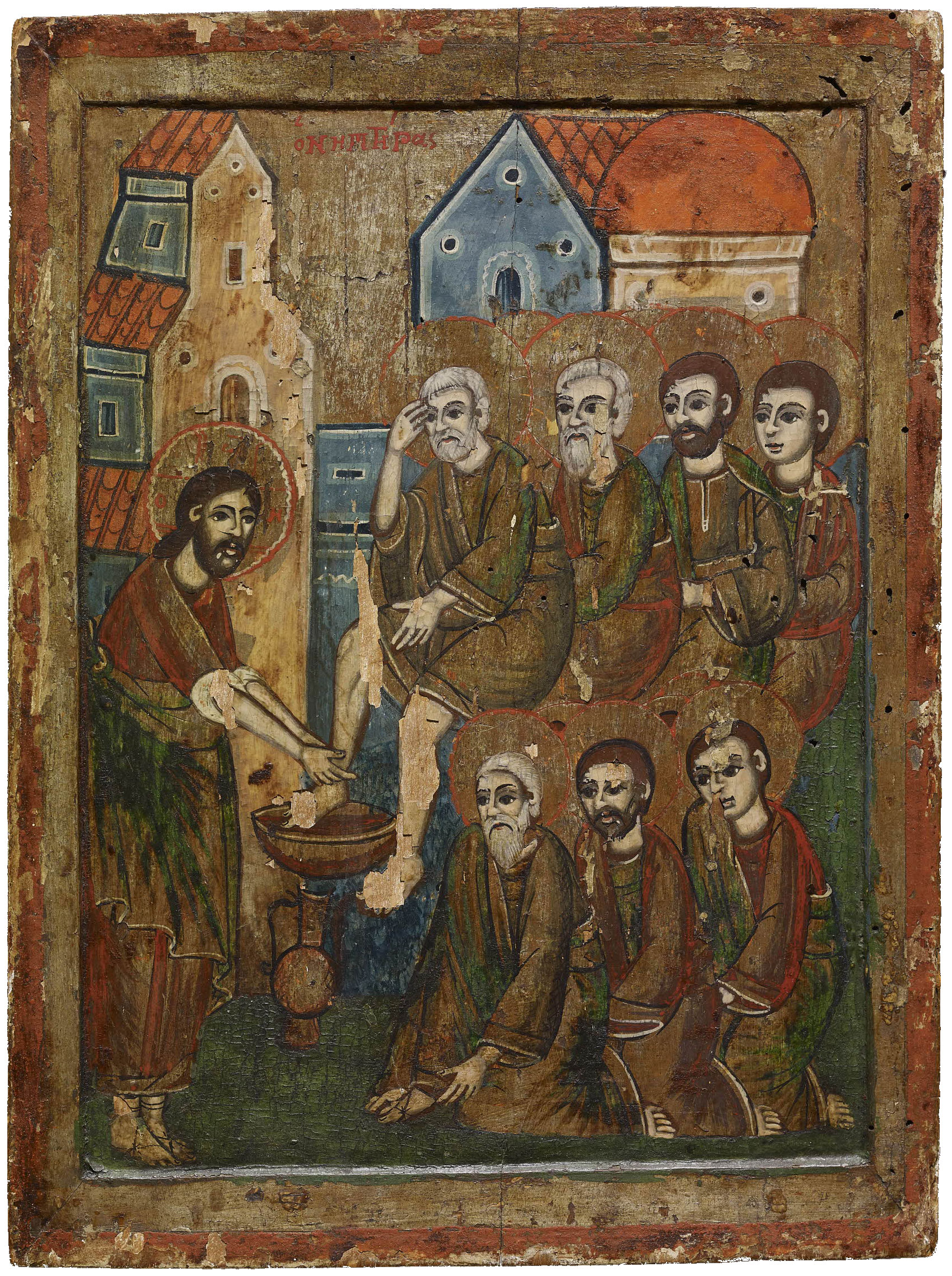The icon is painted in egg tempera with gold leaf on wood primed with gesso; a raised integral border in gold and outlined in red frames the image. Against an architectural background, Christ washes the feet of St Peter. The seven apostles shown are represented in two registers, but the others are implied through their haloes. The outlines of the figures and haloes are deeply incised. The titular inscription is in red majuscule letters in Greek Ο ΝΗΠΤΗΡΑC (misspelled? O NIMTIΡAC), while Christ’s cruciform halo bears the words Ο ω Η (‘He Who Is’) with the Cyrillic letter H replacing the Greek N at the end.
Christ stands on the left with his sleeves rolled up and a towel wrapped around his waist (the Gospel text is John 13:4). He washes the feet of St Peter who touches his head with his right hand, a direct allusion to him asking Jesus to also wash his hands and head (John 13:9). Three apostles are fully represented sitting behind Peter waiting for their feet to be washed, and another three are on the ground in identical postures, removing their sandals. The scene is taking place in front of two buildings with gabled roofs against the traditional gold background. The reverse of the icon is smoothly chiseled and covered with priming. There are traces of woodworm damage.
This panel portrays Christ washing the feet of his disciples, a relatively rare subject for an icon. This iconography with Christ standing on the left and St Peter sitting on the right along with the other disciples is found, for instance, in a 10th-century icon from St Catherine’s Monastery, Sinai (Galavaris 1990) and continues to be in use in the period after 1453, as seen in a 16th-century drawing from the Dionysiou Monastery, Mount Athos, though with a more elaborate iconography (Karakatsanis 1997). The weakness of draughtsmanship is obvious in the rendering of the buildings and the basin, which is portrayed floating in the air, as well as the omission of the piece of furniture where St Peter and the Apostles behind him are meant to be sitting. The figures are robust and their facial features coarse with large eyes and ears forming a c-shape. The outlines are dark and bold, while the flesh areas have a rather flat appearance, rendered with a few shades of pale pink, cream for the skin and grey for the shadowed parts. These characteristics point to a painter of the Tryavna region, Bulgaria, active in the 19th century, one of the most prominent artistic centres during the Bulgarian National Revival. It is stylistically very close to the icons of the Last Supper and the Nativity of the Virgin from the collection of the National Art Gallery, Sofia, both ascribed to a 19th-century painter from that region (Paskaleva 1987).
The subject of the icon in combination with the absence of any traces of hooks or holes for hanging it suggests that it was possibly placed on a stand for veneration during the liturgy on Holy Thursday commemorating the Washing of the Feet, the Last Supper, Christ’s prayer in the garden and Judas’ betrayal. The existence of a Greek inscription on an icon made in that region may indicate that the commissioner was Greek or can be explained by the fact that, in 19th-century Bulgaria, Greek was widely spoken (Konstantios 2002).
Literature: K. Paskaleva, Bulgarian Icons Through the Centuries, Sofia, 1987, 208–11; G. Galavaris, ‘Early Icons (From the 6th to the 11th Century)’, in K.A. Manafis (ed.), Sinai. Treasures of the Monastery of Saint Catherine, Athens, 1990, 91–101, at 99, 144, fig. 12; A. Karakatsanis (ed.), Treasures of Mount Athos (exh. cat., Museum of Byzantine Civilisation), Thessaloniki, 1997, 203, no. 3.2 (with further examples); D. Konstantios, ‘Greece, Hearth of Art and Culture after the Fall of Constantinople’, in G. Kakavas (ed.), Post-Byzantium: The Greek Renaissance. 15th-18th Century Treasures from the Byzantine and Christian Museum, Athens, Athens, 2002, 29–56, at 55; R. Cormack, Icons, London, 2014 (2nd ed.), no. 111, 140.
Eleni Dimitriadou
